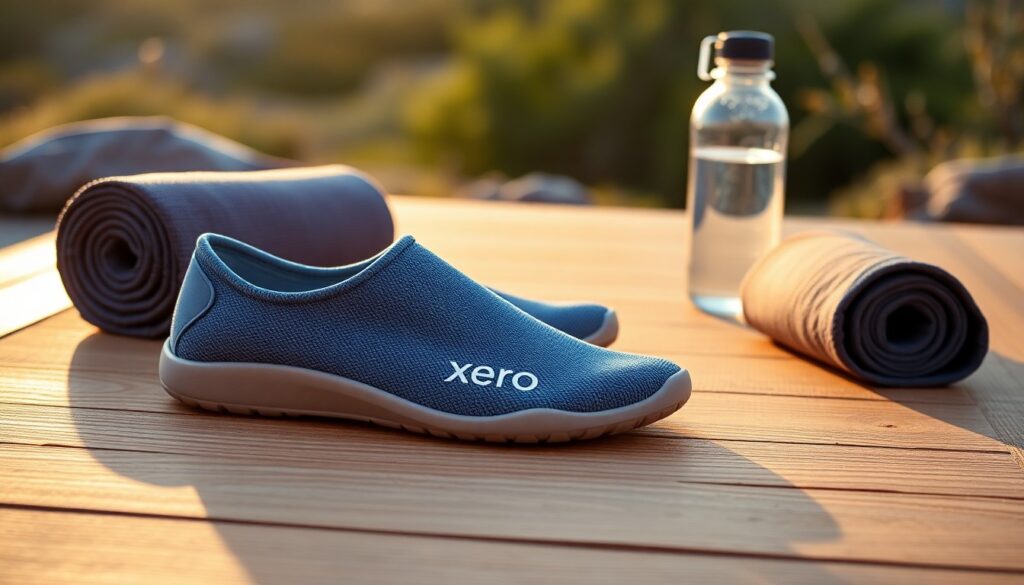
You may already know the benefits of yoga and meditation, but have you considered how your footwear impacts your practice? Barefoot shoes, designed to mimic the natural movement of your feet, offer enhanced balance, flexibility, and a deeper connection to the earth—like a yoga mat for your feet, supportive yet connected to the ground. Unlike restrictive traditional shoes, they encourage proper alignment and reduce injury risks while grounding your energy. Whether you’re flowing through poses or sitting in stillness, barefoot shoes can elevate your mindfulness by bringing you closer to the earth’s natural stability.
Understanding Barefoot Shoes
Your feet are designed to move naturally, and barefoot shoes honor this by mimicking the sensation of walking barefoot while offering protection. These shoes prioritize flexibility, thin soles, and a wide toe box, allowing your feet to splay and grip the ground, much like a yoga mat supports your practice. By wearing them, you enhance balance, proprioception, and grounding—key elements for yoga and meditation.
Definition and Features
Around the concept of barefoot shoes lies the idea of minimalist design. They feature zero-drop soles (no heel elevation), ultra-thin materials, and unrestricted toe space, encouraging natural foot movement. Think of them as a second skin, offering just enough protection to shield your feet without sacrificing sensory feedback.
History and Evolution of Barefoot Shoes
Along the timeline of footwear, barefoot shoes trace their roots to ancient cultures where humans walked and practiced barefoot. Modern iterations emerged in the 2000s, inspired by the barefoot running movement, which highlighted the drawbacks of overly cushioned shoes.
At the heart of this evolution is a return to simplicity. Early adopters sought to strengthen foot muscles and improve posture, leading to innovations like Vibram FiveFingers. Today, barefoot shoes are embraced by yogis and athletes alike for their grounding benefits and alignment with mindful movement.
Differences Between Barefoot Shoes and Traditional Footwear
Behind the design of traditional shoes lies a focus on arch support, cushioning, and rigid structures, which can weaken foot muscles over time. Barefoot shoes, by contrast, promote natural foot function, with flexible soles that let you feel the ground beneath you.
In fact, studies suggest that traditional footwear may contribute to foot pain and imbalances, while barefoot shoes encourage healthier gait patterns. The lack of heel elevation in barefoot shoes also aligns your spine more naturally, reducing strain during yoga or meditation.
Why Barefoot Shoes Are Perfect for Yoga & Meditation
There’s a reason barefoot shoes enhance your yoga and meditation practice—they mimic the natural movement of your feet, allowing greater flexibility and alignment. Unlike restrictive footwear, they encourage a deeper connection to the earth, helping you ground your energy and maintain proper posture. Think of them as a yoga mat for your feet—supportive yet connected to the ground, so you can move freely and focus inward without distraction.
Sensory Feedback and Balance
Sensory input from your feet is vital for stability in yoga poses. Barefoot shoes let you feel the floor beneath you, improving proprioception and fine-tuning your balance. This heightened awareness helps you adjust subtly, ensuring your poses are steady and aligned, much like the mindful attention you bring to your breath.
Natural Toe Splay for Stability
About stability in yoga, it starts with your toes. Barefoot shoes allow your toes to spread naturally, creating a wider, more balanced foundation. This mimics the way your feet would function barefoot, reducing strain on your joints and improving overall posture.
Also, a natural toe splay helps prevent common foot issues like bunions or plantar fasciitis by encouraging proper weight distribution. Over time, this can strengthen the muscles in your feet, making your practice more sustainable and comfortable.
Connection to the Ground
Behind every grounded yoga pose is a strong connection to the earth. Barefoot shoes enhance this by minimizing barriers between your feet and the floor, so you can fully engage with your practice. This direct contact fosters a sense of presence, much like meditation itself.
Consequently, this connection reduces the risk of slipping and helps you maintain stability in challenging poses. The thin, flexible soles act as a second skin, letting you move with confidence while staying rooted in the moment.
Recommended Models for Yoga Enthusiasts
Not all barefoot shoes are created equal for yoga and meditation. You’ll want a pair that balances flexibility and grounding, allowing your feet to move naturally while keeping you stable. Look for models with thin soles for better proprioception and a wide toe box to encourage proper alignment—like a yoga mat for your feet, supportive yet connected to the ground.
Z-Trail EV Sandals
Beside the mat, the Z-Trail EV Sandals offer unmatched breathability and a featherlight feel, perfect for hot yoga or outdoor practice. Their adjustable straps ensure a secure fit, while the zero-drop design keeps your posture aligned. However, the open style may lack warmth for cooler studios.
Prio Neo
At the top of many yogis’ lists, the Prio Neo combines durability with a barely-there feel. Its grippy sole prevents slips during dynamic flows, and the flexible upper moves with your foot. Ideal for both studio sessions and mindful walks.
Enthusiasts praise the Prio Neo for its versatility, but note the slightly thicker sole may reduce ground feedback compared to minimalist options. If you prioritize protection over ultra-thin sensitivity, this model shines—just ensure you break them in gradually to avoid stiffness.
Benefits During Meditation
To deepen your meditation practice, barefoot shoes act like a yoga mat for your feet, fostering a direct connection with the earth. This tactile feedback helps you stay present, aligning your body and mind effortlessly. The minimalist design encourages natural movement, allowing you to focus inward without distractions, making each session more immersive and grounding.
Grounding Effects
Meditation thrives on stability, and barefoot shoes enhance this by amplifying sensory input through your soles. Feeling the floor beneath you anchors your awareness, reducing mental chatter. This physical connection mirrors the mental stillness you seek, creating a harmonious balance between body and environment.
Enhanced Mindfulness and Focus
To sharpen your focus, barefoot shoes eliminate the barrier between you and the ground, heightening proprioception. This awareness of your body in space sharpens mindfulness, helping you notice subtle shifts in posture or breath. The result? A deeper, more intentional meditation experience.
Grounding through barefoot shoes also reduces distractions caused by stiff soles or unnatural foot positioning. By freeing your feet, your mind follows, allowing you to settle into the present moment with ease. This synergy between body and mind cultivates a meditative state more naturally.
Improved Posture and Spinal Alignment
By wearing barefoot shoes, you encourage proper weight distribution across your feet, which naturally aligns your spine. This reduces strain on your lower back and hips, letting you sit or stand comfortably during longer sessions. The result is a taller, more relaxed posture that supports deeper breathing.
At the core of this benefit is the elimination of heel elevation, common in traditional shoes, which can tilt your pelvis forward. Barefoot shoes promote a neutral stance, preventing slouching and allowing your spine to stack naturally. This alignment not only enhances meditation but also prevents long-term discomfort.
The Science Behind Grounding
After slipping into barefoot shoes, your feet connect directly with the ground, enhancing sensory input and activating neural pathways linked to balance and awareness. This grounding effect, rooted in biomechanics, mimics walking barefoot, stimulating proprioceptors and improving posture. Studies suggest this connection may reduce stress by lowering cortisol levels, making it ideal for yoga and meditation. Think of it as a yoga mat for your feet – supportive yet intimately tied to the earth beneath you.
Research Studies on Sensory Feedback
Science reveals that barefoot shoes amplify tactile feedback, sharpening your body’s awareness during movement. A 2018 study found participants in minimalist footwear exhibited improved gait efficiency and heightened sensitivity to terrain. This aligns with yoga’s emphasis on mindfulness, helping you tune into subtle shifts in weight and pressure, fostering a deeper mind-body connection.
Impact on Proprioception
Sensory input from barefoot shoes sharpens proprioception—your body’s ability to sense its position in space. This is vital for yoga poses requiring precision, like Tree or Warrior III. By strengthening foot muscles and refining balance, you cultivate stability both on and off the mat.
For instance, a 2020 study showed that minimalist footwear users experienced 19% better balance after 12 weeks compared to traditional shoe wearers. This underscores how grounding practices can transform your practice, reducing injury risk and enhancing fluidity.
Grounding Practices and Stress Reduction
Against the backdrop of modern life’s chaos, grounding through barefoot shoes offers a refuge. Direct contact with the earth may lower stress hormones, promoting calm during meditation. The tactile feedback acts as an anchor, pulling you into the present moment—important for mindfulness.
Research highlights that grounding techniques, like earthing or minimalist footwear, can reduce inflammation and improve sleep. One study noted a 30% drop in cortisol levels among participants who practiced grounding daily. For yogis, this means a quieter mind and a more resilient nervous system.
Personal Experiences with Barefoot Shoes in Yoga
All practitioners who’ve tried barefoot shoes in yoga report a deeper connection to their practice. The thin, flexible soles act like a yoga mat for your feet, enhancing proprioception and grounding. Many find they can better align their posture and feel subtle shifts in balance, making poses like Tree or Warrior more intuitive. Over time, your feet strengthen naturally, reducing reliance on artificial support and fostering a more mindful practice.
Yoga Instructor Case Study
Study shows instructors who switched to barefoot shoes observed improved stability in balancing poses. One teacher noted students felt more present during meditation, as the shoes eliminated distractions from stiff soles. The natural foot movement also reduced strain during long sessions, proving beneficial for both teaching and personal practice.
Enhanced Balance and Reduced Fatigue
An immediate benefit of barefoot shoes is the heightened awareness of your foot placement, which sharpens balance. The lightweight design minimizes fatigue, letting you hold poses longer without discomfort. Over time, your arches and toes strengthen, reducing strain in standing sequences.
Yoga practitioners often overlook how traditional shoes weaken foot muscles. With barefoot shoes, you reactivate these muscles, leading to better alignment and endurance. This shift can prevent injuries caused by overcompensation in ankles or knees, making your practice safer and more sustainable.
Transitioning from Traditional Shoes
Case in point: switching too quickly can cause muscle soreness or discomfort. Start with short sessions to let your feet adapt. Focus on gentle poses before advancing to intense flows, allowing your body to adjust to the newfound freedom of movement.
Personal experiences highlight the importance of patience. While some feel immediate benefits, others need weeks to adapt. Listen to your body—if you experience pain, scale back. The transition rewards you with stronger feet and a deeper mind-body connection, but rushing it risks injury.
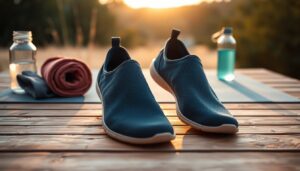
How to Choose the Right Barefoot Shoe
For selecting the perfect barefoot shoes, focus on flexibility, ground feel, and minimal cushioning. Your shoes should mimic the natural movement of your feet, like a yoga mat for your feet—supportive yet connected to the ground. Prioritize a wide toe box to allow toes to splay freely, enhancing balance and stability during poses. Lightweight materials and a zero-drop sole ensure proper alignment, helping you stay grounded in both yoga and meditation.
Consider Your Practice Environment
By thinking about where you practice, you can tailor your choice. For indoor studios, thin-soled options offer maximum sensory feedback, while outdoor sessions may need slightly more durable soles for uneven terrain. If you practice on hardwood or tile, grip is vital to prevent slipping during transitions.
Assessing Comfort and Fit
Assessing comfort starts with trying shoes on and moving as you would in practice. Your toes should have room to spread, and the shoe should feel like a second skin—snug but not restrictive. Avoid anything that pinches or rubs, as discomfort disrupts focus.
With proper fit, you’ll notice improved posture and reduced strain. A well-fitted barefoot shoe encourages natural foot mechanics, preventing long-term issues like bunions or plantar fasciitis. Test them with dynamic movements to ensure they stay secure without constriction.
Evaluating Material and Design
Along with fit, material choice impacts breathability and flexibility. Look for natural fibers like organic cotton or hemp, which wick moisture and adapt to your foot’s shape. Synthetic blends may offer durability but can trap heat, disrupting comfort during longer sessions.
Design plays a key role in performance. A seamless interior reduces irritation, while a flexible sole ensures unrestricted movement. Avoid stiff or overly structured designs—they counteract the benefits of barefoot footwear. Prioritize shoes that enhance, rather than hinder, your connection to the earth.
Common Myths About Barefoot Shoes
Many misconceptions surround barefoot shoes, often deterring people from trying them. Some believe they’re only for athletes or that they lack protection, but these shoes are designed to enhance natural movement while offering minimal interference. Think of them like a yoga mat for your feet – supportive yet connected to the ground. Dispelling these myths helps you make an informed choice for your practice.
Are They Suitable for Everyone?
Myths suggest barefoot shoes work for all, but individual needs vary. If you have severe foot conditions or require orthotics, consult a specialist before transitioning. However, many find them beneficial for improving posture and balance, especially in yoga and meditation.
The Misconception of Zero Support
Suitable for grounding, barefoot shoes don’t lack support—they redefine it. Instead of rigid arches, they encourage your feet to strengthen naturally, much like how yoga builds core stability. The thin sole protects while letting you feel the earth beneath you.
Due to their design, these shoes promote proper alignment and muscle engagement. Over time, this can reduce reliance on artificial support, but transitioning too quickly may strain unprepared feet. Listen to your body and progress gradually.
Understanding Adaptation Time
On switching to barefoot shoes, your feet need time to adjust. Initial discomfort is normal as muscles and tendons adapt to newfound freedom. Start with short sessions during yoga or walks to avoid overexertion.
Hence, patience is key. Rushing the process can lead to injuries, but a mindful approach ensures long-term benefits like better balance and reduced joint stress. Honor your body’s pace, just as you would in a yoga flow.
Maintenance and Care for Barefoot Shoes
Unlike traditional footwear, barefoot shoes require minimal but mindful upkeep to preserve their flexibility and connection to the ground. Treat them like a yoga mat for your feet – supportive yet intimately linked to the earth. Regular care ensures they remain comfortable and functional, enhancing your practice.
Cleaning and Storage Tips
Around the house or after a session, gently brush off dirt with a soft cloth and use mild soap for deeper cleaning. Avoid harsh detergents or machine washing, as they can degrade the natural materials. Air-dry them away from direct heat, and store in a cool, dry place. This simple routine keeps your shoes fresh and ready for your next practice.
- Brush off loose dirt
- Hand wash with mild soap
- Air-dry naturally
Longevity and Durability
Storage plays a key role in extending the life of your barefoot shoes. Keep them in a well-ventilated area to prevent moisture buildup, which can weaken the materials. Rotate between pairs if possible to reduce wear and tear.
In addition, inspect the soles and uppers periodically for signs of thinning or damage. Proper care ensures your shoes maintain their grounded feel, supporting your practice for years.
When to Replace Your Shoes
Barefoot shoes lose their effectiveness when the soles become too thin or the structure loses its shape. If you notice reduced grip or discomfort during poses, it’s time for a new pair. Worn-out shoes can compromise your alignment and connection to the ground.
In fact, replacing them every 6-12 months with regular use ensures optimal support. Ignoring wear can lead to strain or injury, so listen to your body and your shoes.
Integrating Barefoot Shoes into Your Daily Life
Now that you’ve experienced the grounding benefits of barefoot shoes during yoga and meditation, consider weaving them into your everyday routine. Start by wearing them for short walks or errands, allowing your feet to adapt naturally. Over time, your muscles and posture will strengthen, enhancing your connection to the earth. Think of them as a yoga mat for your feet – supportive yet connected to the ground, helping you stay mindful even off the mat.
Transitioning to Barefoot Living
Against the backdrop of cushioned footwear, switching to barefoot shoes requires patience. Begin with 30-minute sessions, gradually increasing wear time to avoid strain. Listen to your body; discomfort signals adjustment, not failure. This shift reawakens your foot’s natural mechanics, fostering balance and resilience.
Activities Beyond Yoga and Meditation
Into hiking, running, or even gardening? Barefoot shoes excel in diverse settings. Their flexible soles and wide toe boxes promote natural movement, reducing injury risk while keeping you grounded. Whether on trails or city streets, they bridge the gap between barefoot freedom and protection.
Even daily chores become opportunities to strengthen your feet. Walking barefoot-style indoors or during light workouts enhances proprioception, sharpening your awareness of body alignment. Over time, you’ll notice improved agility and reduced reliance on artificial support.
Benefits for Overall Foot Health
Transitioning to barefoot shoes can alleviate common foot issues like plantar fasciitis or bunions by encouraging proper toe splay and arch engagement. Unlike traditional shoes, they don’t compress or weaken your feet, fostering long-term mobility.
Barefoot footwear also stimulates nerve endings, boosting circulation and sensory feedback. This isn’t just about comfort—it’s a preventive measure against chronic pain. However, consult a specialist if you have pre-existing conditions to ensure a safe transition.
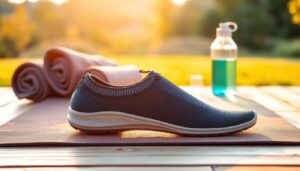
Expert Opinions on Barefoot Shoes
Despite mixed opinions, many experts agree that barefoot shoes can enhance your yoga and meditation practice by promoting natural movement and grounding. Research suggests they may improve proprioception, helping you feel more connected to the earth—like a yoga mat for your feet. However, transitioning too quickly can strain your muscles, so gradual adaptation is key.
Insights from Yoga Professionals
Among yoga instructors, barefoot shoes are praised for their minimalist design, allowing your feet to move freely while maintaining stability. Many note that they encourage better alignment and balance, though some caution against relying on them if you’re new to barefoot movement.
Comments from Foot Health Specialists
Barefoot shoes, according to podiatrists, can strengthen your foot muscles and improve arch support over time. However, they warn that improper use may lead to injuries like plantar fasciitis, especially if you have pre-existing conditions.
Expert recommendations emphasize starting with short sessions and choosing shoes with flexible soles to mimic natural foot movement. Pairing them with foot exercises can maximize benefits while minimizing risks.
Perspectives from Meditation Practitioners
Yoga and meditation enthusiasts often describe barefoot shoes as a tool for deepening mindfulness. The direct ground contact fosters a sense of presence, though some prefer complete barefoot practice for ultimate sensory feedback.
Specialists highlight that while barefoot shoes can enhance your practice, listening to your body is important. If discomfort arises, switching back to traditional footwear temporarily may be wise. The goal is balance—supporting your feet without sacrificing connection.
Frequently Asked Questions
After exploring barefoot shoes for yoga and meditation, you might have questions. Many practitioners wonder about transition periods, benefits for alignment, or how they enhance mindfulness. Barefoot shoes act like a yoga mat for your feet, offering support while keeping you grounded. Whether you’re new or experienced, understanding these details helps deepen your practice.
Comparison with Traditional Yoga Footwear
Between barefoot shoes and traditional yoga footwear, the differences are clear. Below, a quick breakdown:
| | | High, mimics natural foot movement | Often restrictive, with thicker soles | Enhances sensory connection | Reduces tactile feedback | Strengthens foot muscles | Provides artificial arch support
Practical Tips for Beginners
To ease into barefoot shoes, start slow. Focus on short sessions, proper fit, and listening to your body. Assume that gradual adaptation prevents discomfort.
Beginners often overlook foot strength. Try these steps:
- Strengthen arches with toe spreads and lifts
- Walk on varied surfaces to build resilience
- Monitor progress to avoid overuse
Assume that patience leads to better results.
Addressing Concerns about Foot Health
The main worry is whether barefoot shoes harm your feet. Research shows they improve posture and reduce joint strain when used correctly. However, existing conditions like plantar fasciitis may need extra care.
Another key point is transitioning safely. Rushing can cause injury, while gradual use naturally strengthens muscles. Always consult a specialist if you have chronic pain. Barefoot shoes, like yoga, thrive on mindful progression.
Purchasing Considerations
Remember that barefoot shoes should mimic the natural shape of your foot, with a wide toe box and flexible sole. Look for breathable materials like organic cotton or recycled synthetics to enhance comfort during yoga and meditation. Prioritize brands that align with your values, whether it’s sustainability, durability, or minimalist design. Testing the fit is crucial—your toes should splay freely, and the sole should feel like a yoga mat for your feet, supportive yet connected to the ground.
Where to Buy Barefoot Shoes
The best places to find barefoot shoes include specialty footwear stores, eco-conscious boutiques, and online retailers. Brands like Vivobarefoot, Xero Shoes, and Merrell offer dedicated collections for mindful movement. If you prefer trying before buying, check local stores with minimalist footwear. For a wider selection, online marketplaces like Amazon or brand websites often provide detailed sizing guides and customer reviews to help you make an informed choice.
Online vs. In-Store Options
Behind every purchase decision lies the choice between convenience and tactile experience. Online shopping offers a broader range and often better prices, but you miss the chance to feel the shoes firsthand. In-store purchases let you test fit and flexibility immediately, ensuring the shoes meet your needs for yoga and meditation. Weigh these factors based on your priorities—speed, variety, or instant feedback.
Considering the pros and cons, online shopping is ideal if you’re familiar with the brand or rely on detailed sizing charts. However, if you’re new to barefoot shoes, visiting a store can prevent costly mistakes. Some retailers offer free returns, bridging the gap between these options. Always check return policies before buying online to avoid surprises.
Pricing and Budgeting
Any investment in barefoot shoes should balance quality and affordability. Prices range from $50 for budget-friendly options to over $200 for premium, sustainably made pairs. Set a budget that reflects your commitment to grounding practices—think of it as investing in long-term foot health rather than just footwear. Sales and seasonal discounts can help you snag high-quality pairs without overspending.
Where you allocate your funds matters. Premium brands often use eco-friendly materials and superior craftsmanship, justifying higher costs. However, mid-range options can still provide excellent comfort and durability. Avoid the cheapest pairs if they compromise on flexibility or toe space, as ill-fitting shoes can hinder your practice and even cause discomfort over time.
Conclusion
Considering all points, barefoot shoes enhance your yoga and meditation practice by fostering a deeper connection to the earth, much like a yoga mat for your feet—supportive yet connected to the ground. These minimalist footwear options improve proprioception, balance, and alignment, helping you stay present in your movements and breathwork. By embracing barefoot shoes, you honor the natural biomechanics of your feet, grounding your practice in both physical and mindful awareness. Whether on the mat or in meditation, this subtle shift can deepen your sense of stability and harmony, aligning body and mind with every step.
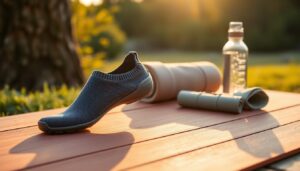
FAQ
How do barefoot shoes enhance the yoga and meditation experience?
Barefoot shoes act like a yoga mat for your feet – supportive yet connected to the ground. They allow for natural foot movement, improving balance and proprioception during poses. The thin, flexible soles help you feel the floor beneath you, deepening your mind-body connection and grounding your practice.
Are barefoot shoes suitable for all types of yoga?
Yes, barefoot shoes complement most yoga styles, from gentle Hatha to dynamic Vinyasa. Their lightweight design and flexible soles mimic the benefits of practicing barefoot while offering subtle protection. Choose breathable materials like merino wool or mesh for hot yoga to maintain comfort and hygiene.
What should I look for when choosing barefoot shoes for meditation?
Prioritize a wide toe box to let your toes spread naturally, like roots grounding into the earth. Opt for zero-drop soles to maintain proper posture during seated meditation. Soft, flexible materials enhance tactile feedback, helping you stay present – think of them as an extension of your mindful awareness.

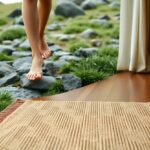



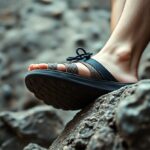


You bring up an intriguing perspective on the intersection of bamboo-grounded footwear and yoga practice. While I appreciate the intention behind barefoot shoes, I wonder if there is a potential downside that isn’t often discussed. For instance, transitioning from traditional footwear to barefoot shoes can be a significant shift for many, leading to discomfort or injury if not approached gradually.
I’ve never really thought about how much my footwear could affect my yoga practice until I read this. I often find myself feeling a bit disconnected when I wear traditional shoes, especially when I’m trying to focus on grounding in poses like Tree or Downward Dog. The idea of barefoot shoes makes so much sense, almost like a natural extension of the earth beneath me.
I find the discussion around barefoot shoes intriguing, especially given the growing awareness of how footwear affects our overall health. Having transitioned to minimalist shoes in my own practice, I’ve noticed a significant improvement in both my stability and comfort during yoga sessions. However, I wonder about the potential downsides—like the adjustment period required for those who are used to traditional footwear and might be at risk of injury during that transition.
I couldn’t agree more about the impact of footwear on our yoga practice. Since switching to barefoot shoes, I’ve noticed a huge difference—my balance feels more grounded, and I’m more aware of how my feet interact with the mat. It’s interesting to think about how society has pushed us toward traditional shoes, often prioritizing style over function. I’ve found that embracing the natural movement of my feet has not only helped in yoga but also in everyday activities.
I’ve never really thought about how my footwear affects my yoga practice until now. It makes sense that wearing shoes designed to mimic barefoot movement would enhance not just balance but also my overall sense of connection to my practice and to the environment around me. I often find that when I’m grounded, both physically and mentally, I can flow more deeply into each pose.
This is such an interesting point! I never really thought about how my shoes could be contributing to my chakras until now. It’s like I’ve been trying to flow with one foot stuck in a concrete block! I mean, using barefoot shoes feels like training my feet to do yoga while they’re still trying to master the art of balancing my Netflix binge-watching. Plus, I can’t help but imagine the moment when my toes finally get their freedom. They might throw a party!
It’s fascinating to think about how our footwear can impact our overall energy and balance, isn’t it? The idea of being stuck in a concrete block while trying to flow really resonates. It’s kind of like how we often ignore the little things, like our posture or the alignment of our bodies, that can throw off our entire sense of well-being.
The connection between our footwear and our practice really does seem to be an under-discussed aspect of yoga and meditation. I’ve recently started practicing in barefoot shoes, and I’ve noticed a significant difference in how grounded I feel during my sessions. It’s fascinating how something as simple as footwear can alter our balance and body awareness. I’ve also read about the concept of proprioception, which refers to the body’s ability to sense its position and movement, and I can see how barefoot shoes could enhance that awareness.
I really appreciate your insights on the interplay between footwear and mindful practices like yoga and meditation. I’ve personally transitioned to barefoot shoes over the past few months, and the difference in how connected I feel to the ground is remarkable. It’s fascinating to consider how something as simple as what we wear on our feet can affect our overall balance and stability throughout our practice.
You make a compelling case for barefoot shoes as essential tools for amplifying our yoga and meditation practices. I’ve personally experienced how transitioning to minimalist footwear has transformed not just my alignment but also my overall mindfulness during sessions. There’s something grounding and liberating about feeling the texture of the earth beneath your feet.
I completely resonate with what you’re saying about barefoot shoes transforming your alignment and mindfulness in yoga and meditation. There’s something quite special about that direct connection to the ground—it almost feels like a reminder to be present and engaged with the moment.
You know, the idea of barefoot shoes really tickles my fancy! I mean, it’s about time our footwear caught up with our Zen practices, right? When I first tried yoga, I was a bit stiff—both mentally and physically. I remember wearing these clunky, heavily cushioned shoes that felt more like ankle weights than supportive companions. I’d stumble through my downward dogs like an unintentional comedy routine. I could practically hear my feet shouting, “Let us breathe!”
This perspective on barefoot shoes really resonates with me. I’ve always felt that the connection to the earth is crucial in both yoga and daily life. I recently switched to barefoot shoes during my practice, and the difference in my stability and balance has been profound. It’s fascinating how something as simple as footwear can enhance our mindfulness and bring us closer to that feeling of being grounded.
Your insights on the role of footwear in yoga practice resonate with my own experiences. Transitioning to barefoot shoes has indeed transformed my connection with the mat and the ground beneath me. I’ve noticed that the flexibility and wide toe box not only enhance my balance during poses but also encourage a more mindful approach to my practice.